Cobra Guppy is a trendy tropical aquarium fish kept by many hobbyists and beginners due to its vibrant color flow and adaptableness for any water conditions.
Also, you can find these beautiful species widely across Central and Southern America, mainly in Barbados, Guyana, Trinidad, Venezuela, and Brazil.
In this guide, we will be talking more about this vibrant cobra guppy. Then, we will tell you all you need to know about caring for and breeding these fishes.
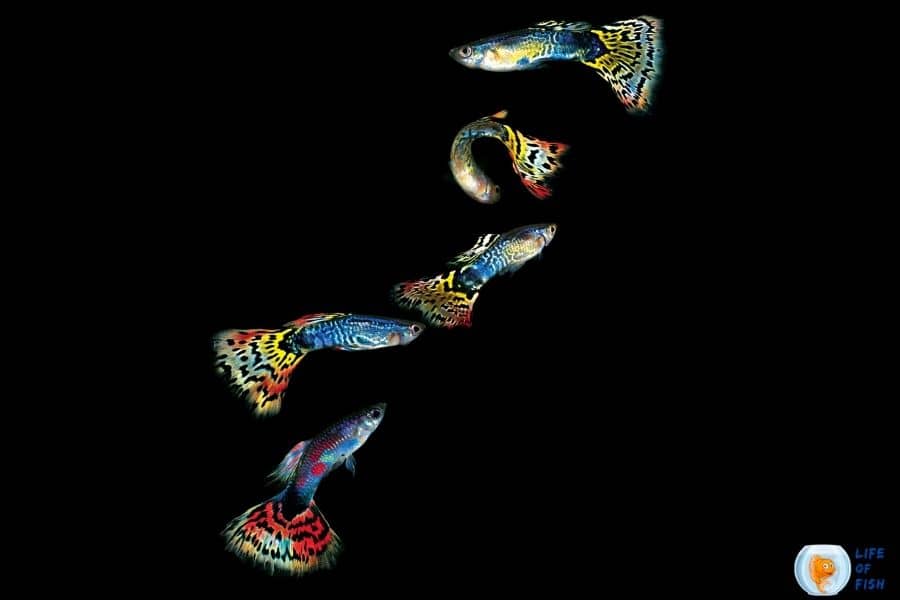
What is cobra guppy & Appearance?
Jump To
- 1 What is cobra guppy & Appearance?
- 2 Types of cobra guppy
- 3 The behavior of cobra guppy
- 4 Cobra guppy lifespan
- 5 Cobra guppy care in Aquariums
- 6 Cobra guppy breeding
- 7 How to feed a cobra guppy?
- 8 What fish can live with a cobra guppy in an aquarium?
- 9 Can I put guppies with cobra fish?
- 10 Cobra guppy diseases
- 11 Related Questions
- 12 One look Care guide
Cobra guppy’s name was given due to its resemblances of a snake-like spotted pattern that runs across its body.
These Guppies are also known as millions fish, ornamental guppy, fancy millions fish guppy, and rainbow fish.
Furthermore, the scientific name for these species is Poeciliia reticulata. The word Poecilia means ‘many-colored,’ and reticulata means ‘net-like,’ which is deficient for these beautiful vibrant little fishes.
Moreover, these fishes are so unique where no one fish looks the other or carries the same color variation.
Interestingly, these guppies have a beautiful multicolored pattern in their bodies, so these species are so popular in the aquarium industry across the world.
Did You Know – This vibrant Poecilia reticulata was first narrated by Wilhelm Peters in early 1859. A specimen taken in early 1866 by botanist Dr. Robert Guppy was sent to Europe, and the spices were named after him.
However, guppies have an extended body that would measure between 1.2 and 2.4 inches long. And also it has color morphs that seem endless in their bodies.
Usually, you will notice that the male species of these guppies are more vibrant in color and has a more extensive flowing tail.
On the other hand, the female species tend to have a dull color pattern compared to the male fish.
Interesting Fact – These species have teeth in both the lower and upper jaw. Like many other members of the Poecilidae family of fishes.
Breeding for color
Just like most fancy-looking guppies, even cobra guppies start with a ‘ground color.’That is upper body color. A ‘cover.’ which covers vibrant, iridescent patterns over the fish’s lower body.
You can see these species in four ground colors.
- Albino
- Wild- Color
- Blue
- Blond
Covers can be any conceivable color or a mixture of colors where most of them have specific names.
- Cobra (rosette pattern with vertical bars)
- Carpet
- Snakeskin
- Black or “tux.”
There are 11 different tail forms in fancy guppies, which are.
- Veil tail
- Delta
- Round-tail
- Pintail
- Lyretail
- Flag tail
- Fantail
- Spade tail
- Swordtail
- Spear tail
- Triangle tail
Did You Know – Each guppy variety is named by tail color.
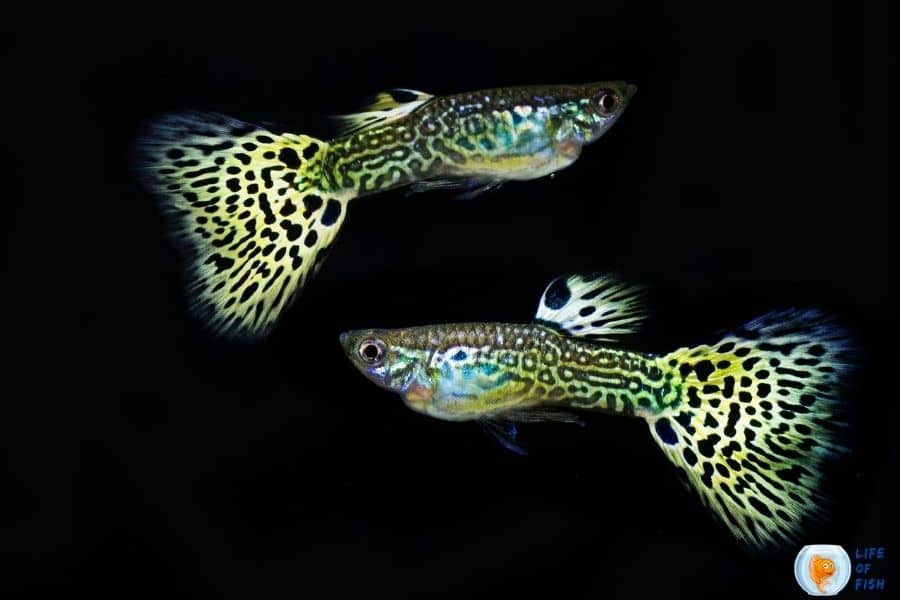
Types of cobra guppy
Blue Cobra Guppy
The blue cobra guppy is one of the most vibrant of all fancy guppies.
Also, the male species of these fish have a darker blue body along with a well-defined colorway and snakeskin body pattern and has an orange and black spotted tail and dorsal fin.
In addition, these fishes are well known for their rosette pattern with vertical bars on their lower body.
Red Cobra Guppy
The red cobra guppy, also known as millions of fish or fancy guppy, is a different variety of Poecilia reticulata guppy.
Furthermore, these guppies were developed through years of careful selective breeding. As a result, the species have a very bright red colorway.
However, these fishes are well known for their rosette pattern with vertical bars on their lower body.
The behavior of cobra guppy
These species are very peaceful and like being in groups.
However, guppies are active swimmers and move a lot in the tank. Most of the time, the male guppy tries to impress the female guppy by chasing them by wiggling their tail.
Is a cobra guppy aggressive?
Yes, it depends, and very rarely, these peaceful species will turn aggressive and attack each other or harm others.
Typically, these cobra guppies are very friendly and highly active. They will swim around the tank and interact with their tank mates.
So, if you see any aggressiveness with your set of guppies, it is mainly due to too many males and not enough females in the tank.
However, make sure that you are doing everything you can to reduce the chances of these peaceful species becoming aggressive.
Cobra guppy lifespan
When it comes to captivity, these guppies will usually live around one to three years. However, if treated well, these guppies might live for around four years.
Did You Know –The guppy’s lifespan will reduce if kept in warmer waters. That will cause the guppies metabolism to increase,
What about the wild guppies? The answer is that just as the guppies in captivity, the wild guppies have a lifespan of one to three years.
But unlike in captivity, wild guppies’ lifespan might affect a few other factors, such as wild predators like birds and bigger fish.
However, the predators will eat guppies or sometimes in extreme weather conditions such as constant rain and flooding, or high cold temperatures will harm or kill the wild guppy.
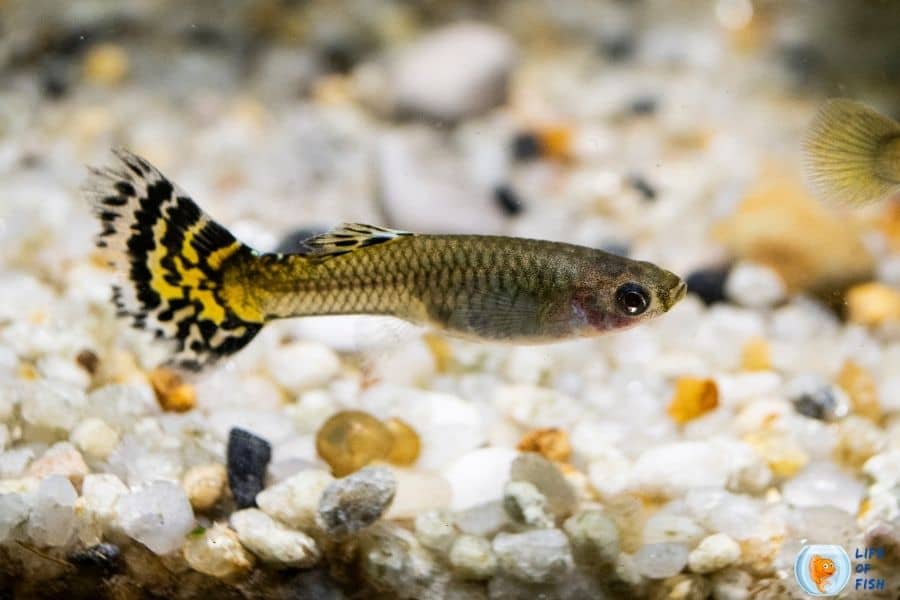
Cobra guppy care in Aquariums
Cobra guppy tank size
The cobra guppy requires an aquarium of at least 10 to 20 gallons.
How many cobra guppies should be kept together?
The number that needs to be kept in one tank depends on your requirement. But the basic rule of keeping fish in tanks is one gallon per one inch.
Therefore in a 10 gallons aquarium, you can keep up to 10 inches. To make it easier, you can add five two-inch long males to an aquarium of this size.
Tank setup
When setting up a tank, make sure that you know the natural habitat of the aquatic animals you want to keep.
Furthermore, consider replicating the natural habitat as closely as possible into your tank.
Now when it comes to the cobra guppies, these are freshwater species that originated from the warm waters of South America.
So, make sure that the proper parameters have been taken into consideration before releasing.
First, you must have a proper filtering system that would adequately cycle your tank’s water. Hang–on–back filter will be fine for most tanks.
Then, ensure that any beneficial bacteria are kept to convert any harmful compounds into less harmful ones.
Make sure that you have a good water heater to heat the tank’s water up to 68 to 82F.
You can place the heater on one side of the tank and the thermometer at the other end of the tank, which will allow you to monitor the heat of your tank’s water.
However, the setup of your tank purely depends on your requirement in keeping this fish. For example, whether you want to keep them to care for, do you want to breed them or keep all males or females?
Show Tank
Make sure that you have plenty of aquatic plantation in the tank. The best type of plants to keep with these fish is Hornwort and Amazon Sword Plants.
Also, keep decorative items such as rocks, driftwood, and you can use any substrate to your tank depending on your preference since guppies spend most of their time in the middle and top of the tank.
Breeding Tank
Keep your tank bare-bottomed. This way, you can clean your tank very quickly. You can use natural aquatic plants.
For example, java moss can create a great hiding place for the fry. Keeping plants in your tank helps to filer the water.
Suppose you notice that your adult fish are hiding. Most probably, it’s due to high levels of stress.
If not, these fishes must be highly active and swimming around the tank. Make sure that the tank is cleaned every week with a partial water change of 25%.
Water quality condition
The temperature of the tank’s water must be between 68 to 82F. Ensure that your tank’s pH levels are between 6.8 and 8.5, and the water hardness must be between 10 and 28 dGH.
Always keep in mind that guppies don’t like high water flows. So make sure that the flow in your tank is weak or moderate.
Special tips
Even though these species are not brackish water fish, Guppies do appreciate small amounts of salt in the water at a rate of roughly 1 to 2.5 teaspoons per gallon of water.
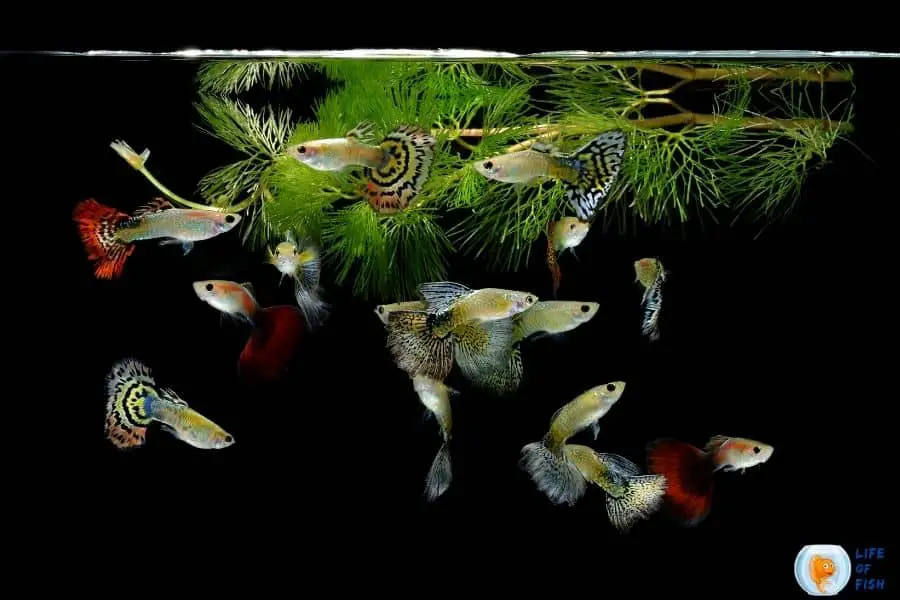
Cobra guppy breeding
Identify female cobra guppy.
The female guppy will have the dorsal fin located on the top of her, about two to three inches from the fish’s head.
Also, female guppies have a shorter dorsal fin which does not trail in the water as they swim.
Cobra guppy male vs. female differences
Usually, you will notice that the male species of these guppies are more vibrant in color and has a more extensive flowing tail.
On the other hand, the female species tend to have a dull color pattern compared with the male fish.
How to breed
Male guppies can identify females who are virgins and who are already pregnant. These species would breed like crazy even without any help from the tank owner.
Further, guppies are ovoviviparous, which means the female usually grows the fish fry inside their bodies, inside eggs.
Moreover, the baby guppies will use the egg sac for nourishment, and once they have absorbed that, they will start to hatch inside the female guppy body, and the female will then give birth to the young guppy fry.
But the question still everyone has is how do they breed?
However, the male guppy will have short contact with the female fish where the fertilization happens when the male fish starts to transfer packages of sperms known as spermatophores into the female.
Also, these packs will then separate into thousands of sperms, and the female would store these to create several broods.
Thus, the female guppy can get pregnant multiple times with only one fertilization over a period.
To fertilize the egg, it will take them at least four to five days, and for the rest of the pregnancy period, the fish will start to develop organs.
Also, the pregnancy period is typically between 21 to 30 days. If you observe very closely from the fish’s translucent skin, you might see the babies’ eyes towards the end of her pregnancy.
Once the female guppy has given birth to the live fry, this same process will repeat, and the female guppy will start to give birth in another 21 to 30 days.
Like we informed you before, regardless of your input, these guppies will breed. Try breeding trap using a breeding tank around a week before the fish deliver the babies.
Once the baby fry is born, you can remove the female guppy from the tank, preventing her from eating the baby fry.
However, if you choose to keep your pregnant fish in a breeding trap, keep in mind to have plenty of room for her to swim.
Finally, If the trap is too small, the fish might stress her out, which might lead to a miscarriage.
Did You Know – Decorative grass is ideal for guppies to lay their offspring. And even for the baby fry to hide.
How many babies do cobra guppy have?
Guppies can have around 2 to 200 babies at a time. These guppy babies are born one after the other in small batches over 6 hours.
Since the pregnancy period is less than a month, these fishes can give birth every 30 days, even in low conditions.
Did You Know – An average female guppy can give around 2000 babies through their lifespan.
How to care fry
Juvenile guppies have speedy metabolisms and will not have the ability to survive without a consistent food supply.
Therefore, you must feed your baby fry several times per day. Several feedings per day are highly required in the beginning stage.
However, it is advised to keep the baby fry in a breeding box, making it easier to feed your baby guppies without any hassle from other tank mates.
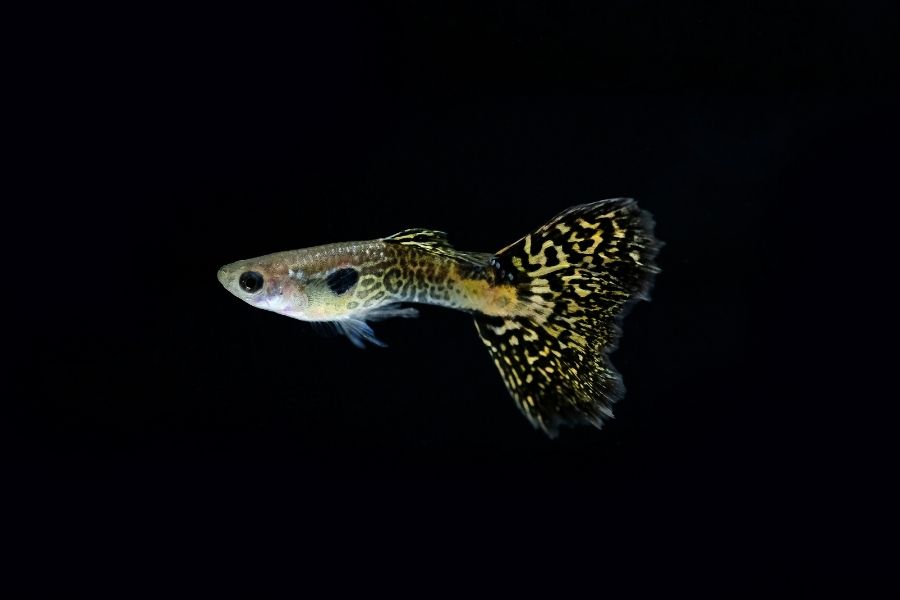
How to feed a cobra guppy?
What to Feed cobra guppy in the Aquarium
Cobra guppies are omnivores, which means they eat plants as well as animal matter.
Further, the best thing about guppies is that these species are not that picky when it comes to food. Because they eat whatever you give them, including mosquito larvae.
Also, you can give them fish flakes as their main diet. However, make sure to provide them with some high protein and not filler foods.
For example, avoid feeding your guppies fish flakes that have fillers such as wheat and soy—instead, feed your guppies with live or frozen animal matter such as shrimps or bloodworms.
Also, You can provide them with vegetables such as peas, lettuce, and cucumber.
Furthermore, you can use a triangular cone feeder, which you can use to feed them live and frozen foods such as bloodworms.
Then, the fish can swim toward the plastic mesh and pull the food out of one of the many holes available.
Please note that you must not feed your fish one type of food. Doing so will lead to nutrient deficiencies.
You must always have a meal plan that changes from flake food, live, frozen, and vegetable foods.
Also always remember to avoid overfeeding your guppies. Doing so will harm their health and foul the water in your tank.
However, if you have any baby guppies in the same tank, you might want to think about feeding them because you need to provide the fry in smaller amounts and frequently.
Finally, That can be done either with the same food you are using to feed the adult fish and make sure that you have crushed it.
If not, you can even buy dedicated fry food to provide your fry at least four times a day.
How long can cobra guppies go without food?
A healthy adult guppy can stay without food for up to 2 weeks.
However, younger guppies and guppy fry will not survive without regular feeding since these younger guppies do not have enough fat stored to keep them through a long fasting period.
Keep in mind the bigger the guppy fish, the longer it can go without food—this principle is applicable to guppies in the wild and captivity.
Further, it is best to take necessary fail-safe measures to make sure guppies will have the best chances of survival while you are away.
When to feed
You can feed your guppy flakes in the morning and any other alternative food in the evening.
How much to feed
You can feed your guppies once or twice a day. However, always remember to provide them with only an amount of food they can eat within two minutes.
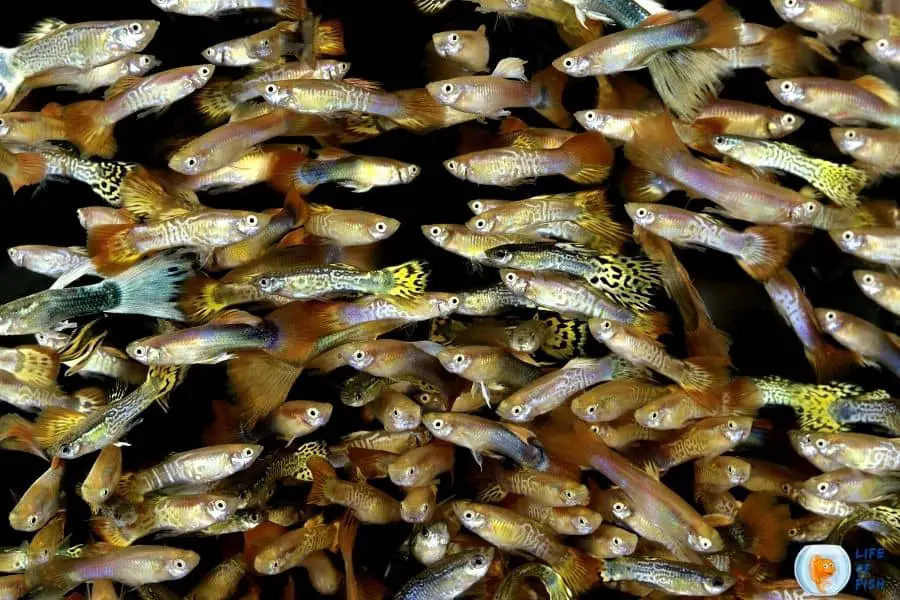
What fish can live with a cobra guppy in an aquarium?
Guppies are very peaceful and active fishes suitable to live in a community tank with other good-natured fish.
However, always remember that guppies will eat fish fry. Therefore, make sure that you provide lots of cover for the babies.
Here are some of the fishes which you can keep alongside the guppies.
- Tetras.
- Corydoras.
- Platy Fish.
- Shrimps.
- Snails.
Guppies can be mixed with other characins and other invertebrates.
Can I put guppies with cobra fish?
Yes, you can keep cobra guppies along with any other breed of guppies. However, make sure to populate the female fish a bit more than the male to avoid getting harassed.
Cobra guppy diseases
Cobra guppies don’t suffer any specific diseases and are very hardy fish to keep. Considering that your fish tank is clean, make sure that you perform partial water changes every week.
Then, with a high-quality diet consisting of livestock, your fish will remain healthy and happy.
Nevertheless, there are few common fish diseases that your guppies may suffer. Below are a few for your reference.
White spot disease
That is one of the most common diseases in tropical freshwater fish. The white spot is caused by the aquatic protozoan parasite, Ichthyophiruis multifilis, also known as ich.
However, Guppies infected with ich rub against the bottom and any solid surfaces within the tank. After a few days, you will notice some sprinkling white dots in the fish’s fins, gills, and body.
Also, White spot disease is easily treatable and not to worry. First, you must increase the water temperature to 82 degrees Fahrenheit and add a counter ich medication to the water.
Flukes
That is a giant parasite that hooks onto the fish body and gills.
Further, any infected fish will try to remove this parasite by rubbing their bodies against the bottom or any hard surface available in the tank.
Sometimes you might see mucus oozing from their bodies due to the irritation that the flukes cause.
However, flukes can be treated by adding antiparasitic medication into your tank.
Fungus
Sometimes you may see any fluffy white growths on your fish. It is due to a fungus infection. Nothing to worry you can treat this fungus with an antifungal medication.
Bacterial infection
You can get many types of Bactria in the tank, which will only become an issue if your fish starts to look weak and stressed or if your fish is injured where the Bacteria could infect the fish through that opening.
By any chance, if you see your cobra guppy with red patches on its skin or blisters or sores, this means that your fish has a bacterial infection that is also treatable.
You can get an over-the-counter antibacterial solution to treat this.
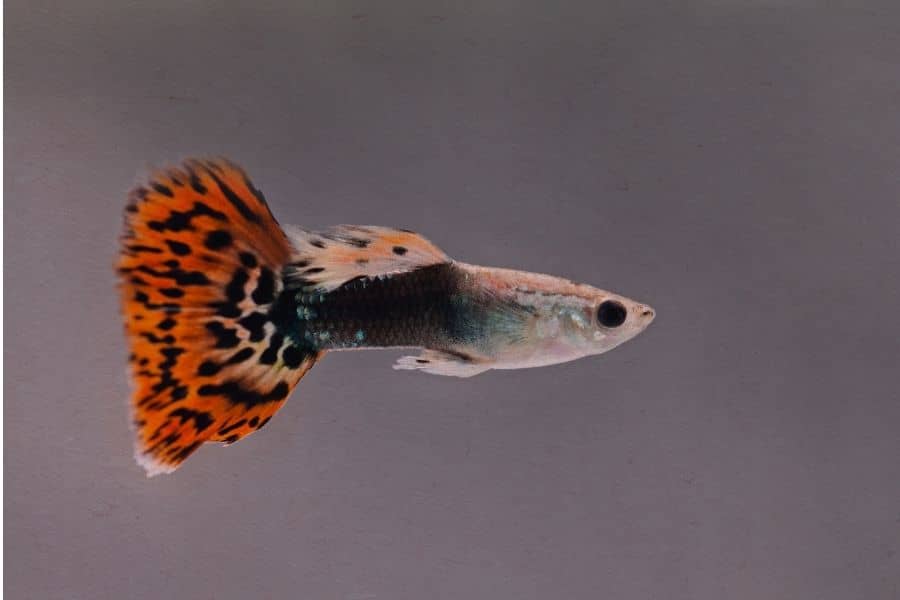
Related Questions
Cobra guppies eat plants
Yes, Cobra guppies are omnivores, which means they eat plants.
Are cobra guppies rare?
Not all, but the blue variegated cobra is also known as galaxy blue glass guppy, stands the fourth-place rarity in the world guppy contest.
How much is a cobra guppy worth?
The price of guppy fish depends on its stain and characteristics. For example, a cobra guppy can be sold from $25 will go as higher as $60.
One look Care guide
| Scientific name | Poeciliidae |
| Common name | Cobra Guppy |
| Care level | Easy |
| Reef Compatible | Freshwater plants and substrate |
| Native to | Coastal streams of Northeast South America |
| Type (soft or hard coral) | Soft |
| Color | Black, Green, Red |
| Tank size | 10 Gallons |
| Preferred temperature | 68 to 82OF |
| Other water parameters (ammonia, etc.) | 64-82° F, KH 10-30, pH 5.5-8.0 |
| Lifespan: | Up to 2 years |
| Size | 0.6 – 2.4 inches |
| Growth rate | Very Fast |
| Temperament | Peaceful |
| Recommended tank mates | Tetras.Corydoras.Platy Fish.Shrimps.Snails.Guppies can be mixed with other characins and other invertebrates. |
| Preferred food | Fish pellets, flakes, live or frozen foods such as shrimp and bloodworms or vegetables such as peas. Lettuce and cucumber |
| Feeding frequency | 1 – 2 times a day |
| Diet | Omnivores |
Read Next: Differences And Similarities Between Rainbow and Red Tail Shark
